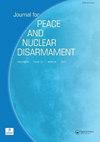朝鲜可能使用低当量核武器
IF 1.4
Q4 INTERNATIONAL RELATIONS
引用次数: 1
摘要
摘要本报告探讨了在朝鲜半岛可能发生冲突的背景下,低当量核武器的潜在用途。它从低当量武器的定义开始——通常是指当量为10千吨或以下的武器,设计为非战略或“战术”武器,与短程投送系统一起使用,用于攻击部队或战场基础设施。然后,本文回顾了美国关于低当量武器立法的历史,并描述了拥有低当量武器的敌人在军事冲突中可能选择或不选择使用这些武器的三种一般情况。根据HYSPLIT模型,提供了一年中不同时间朝鲜非军事区某地点0、3和10千吨爆炸的放射性沉降图示例。对东北亚拥有核武器的国家和美国的低当量武器库进行了比较,提出了涉及朝鲜半岛的7种可能的低当量核武器“使用案例”。本文章由计算机程序翻译,如有差异,请以英文原文为准。
Potential Use of Low-Yield Nuclear Weapons in a Korean Context
ABSTRACT This report explores the potential uses of low-yield nuclear weapons in the context of a possible conflict on the Korean Peninsula. It starts with a definition of low-yield weapons – typically, weapons with yields of ten kilotons or less that are designed to be nonstrategic or “tactical” weapons used with shorter-range delivery systems, prepared for the purpose of attacking troops or battlefield infrastructure. The paper then reviews the history of United States legislation regarding low-yield weapons and describes three generic scenarios in which foes possessing low-yield weapons might choose, or not choose, to use them during a military conflict. Examples of radioactive fallout maps are provided based on HYSPLIT modeling for explosions of 0, 3, and 10 kilotons at a location in the Korean demilitarized zone at different times of the year. The arsenals of low-yield weapons in the states possessing nuclear weapons in Northeast Asia, as well as the United States, are compared, and seven possible “use cases” for low-yield nuclear weapons involving the Korean Peninsula are put forward.
求助全文
通过发布文献求助,成功后即可免费获取论文全文。
去求助
来源期刊

Journal for Peace and Nuclear Disarmament
INTERNATIONAL RELATIONS-
CiteScore
1.30
自引率
0.00%
发文量
36
审稿时长
12 weeks
 求助内容:
求助内容: 应助结果提醒方式:
应助结果提醒方式:


